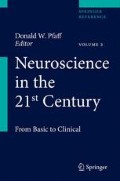Abstract
This chapter deals with relatively simple motor reactions evoked by peripheral stimuli and mediated by neuronal networks in the spinal cord. It will describe the basic mechanisms of reactions evoked by various stimuli as well as their pathological changes in humans, interactions between these reactions, and how they are used as building blocks of our motor reactions.
Access this chapter
Tax calculation will be finalised at checkout
Purchases are for personal use only
Abbreviations
- EPSPs:
-
Excitatory postsynaptic potentials
- GABA:
-
Gamma aminobutyric acid (inhibitory transmitter)
- EMG:
-
Electromyogram
- H-reflex:
-
Hoffmann’s reflex
- H wave:
-
Component of the H-reflex
- M wave:
-
Component of the H-reflex
- NA:
-
Noradrenaline
- 5-HT:
-
Serotonin
- VGLUT1:
-
Vesicular glutamate transporter one
- VGLUT2:
-
Vesicular glutamate transporter two
Further Reading
Baldissera F, Hultborn H, Illert M (1981) Integration in spinal neuronal systems. In: Brooks VB (ed) Handbook of physiology. The nervous system. Motor control. American Physiological Society, Bethesda, pp 509–595
Berkowitz A (2008) Physiology and morphology of shared and specialized spinal interneurons for locomotion and scratching. J Neurophysiol 99:2887–2901
Burke RE (1999) The use of state-dependent modulation of spinal reflexes as a tool to investigate the organization of spinal interneurons. Exp Brain Res 128:263–277
Fleshman JW, Lev-Tov A, Burke RE (1984) Peripheral and central control of flexor digitorum longus and flexor hallucis longus motoneurons: the synaptic basis of functional diversity. Exp Brain Res 54:133–149
Iles JF, Pisini JV (1992) Cortical modulation of transmission in spinal reflex pathways of man. J Physiol (Lond) 455:425–446
Jankowska E (2008) Spinal interneuronal networks in the cat; elementary components. Brain Res Rev 57:46–55
Jankowska E, Hammar I (2002) Spinal interneurons; how can studies in animals contribute to the understanding of spinal interneuronal systems in man? Brain Res Rev 40:19–28
Kandel ER, Schwartz JH, Jessell TM (eds) (1991) Principles of neural sciences. Elsevier, New York
Lundberg A (1975) Control of spinal mechanisms from the brain. In: Tower DB (ed) The basic neurosciences. Raven, New York, pp 253–265
McCrea DA (1986) Spinal cord circuitry and motor reflexes. Exerc Sport Sci Rev 14:105–141
McCrea DM (1992) Can sense be made of spinal interneuron circuits? Behav Brain Res 15:633–643
McCrea DA, Rybak IA (2008) Organization of mammalian locomotor rhythm and pattern generation. Brain Res Rev 57:134–146
Moschovakis AK, Sholomenko GN, Burke RE (1991) Differential control of short latency cutaneous excitation in cat FDL motoneurons during fictive locomotion. Exp Brain Res 83:489–501
Nielsen JB, Crone C, Hultborn H (2007) The spinal pathophysiology of spasticity–from a basic science point of view. Acta Physiol (Oxf) 189:171–180
Pearson KG (1993) Common principles of motor control in vertebrates and invertebrates. Annu Rev Neurosci 16:265–297
Pierrot-Deseilligny E, Burke D (2005) The circuitry of the human spinal cord: its role in motor control and movement disorders. Cambridge University Press, Cambridge
Prochazka A, Clarac F, Loeb GE, Rothwell JC, Wolpaw JR (2000) What do reflex and voluntary mean? Modern views on an ancient debate. Exp Brain Res 130:417–432
Schouenborg J (2008) Action-based sensory encoding in spinal sensorimotor circuits. Brain Res Rev 57:111–117
Acknowledgments
The research work in author’s laboratory has been supported by grants from the Swedish Research Council (15393-01) and from the NINDS/NIH (R01 NS040863). Comments from Dr. Robert Burke and Dr. Emmanuel Pierrot-Deseilligny are gratefully acknowledged.
Author information
Authors and Affiliations
Corresponding author
Editor information
Editors and Affiliations
Rights and permissions
Copyright information
© 2013 Springer Science+Business Media, LLC
About this entry
Cite this entry
Jankowska, E. (2013). Spinal Reflexes. In: Pfaff, D.W. (eds) Neuroscience in the 21st Century. Springer, New York, NY. https://doi.org/10.1007/978-1-4614-1997-6_50
Download citation
DOI: https://doi.org/10.1007/978-1-4614-1997-6_50
Publisher Name: Springer, New York, NY
Print ISBN: 978-1-4614-1996-9
Online ISBN: 978-1-4614-1997-6
eBook Packages: Biomedical and Life SciencesReference Module Biomedical and Life Sciences

